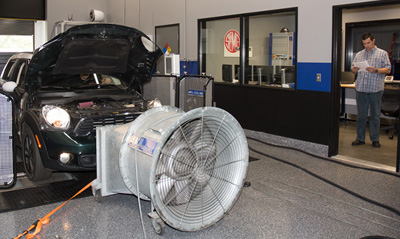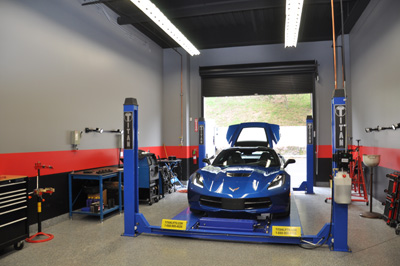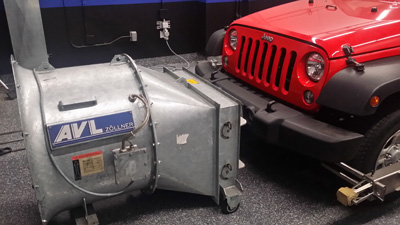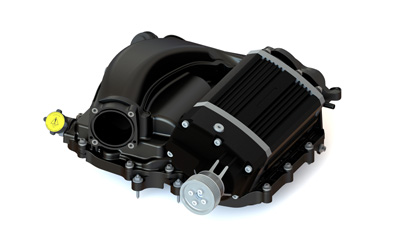SEMA News—October 2016
BUSINESS
Fast Track to Emissions Compliance
A New SEMA Garage Program Cuts the Red Tape
Performance products drive innovation and consumer enthusiasm, guaranteeing the continued health and growth of every business in the distribution chain, from manufacturers to retailers and marketers to media. And because clean-air regulations govern so much of the manufacturing, sale and use of products in this category, SEMA has long emphasized the need for emissions compliance on the part of its member manufacturers while simultaneously striving to protect them from overly burdensome regulation.
Recently both the California Air Resources Board (CARB) and the federal U.S. Environmental Protection Agency (EPA) have stepped up their enforcement of air-quality regulations relating to these products—in some cases leveling crippling fines on non-compliant manufacturers. This in turn has sent chills through the entire aftermarket, with warehouse-distributors and even retailers now giving more scrutiny than ever to the products they carry. (See “Emissions Compliance,” SEMA News, July 2016.)
 The new SEMA Garage fast track program has helped cut the red tape for emissions testing, allowing product manufacturers to complete their tests and receive a CARB Executive Order in as little as two to three months. Prior to this cooperative program with CARB, the process could take anywhere from six months to a year or more. |
For manufacturers, the means of emissions compliance has traditionally been to seek an Executive Order (EO) certification from CARB (see sidebar on p. 130)—often an expensive, time-consuming process. Fortunately for SEMA members, the recently established SEMA Garage Emissions Compliance Center in Diamond Bar, California, has come up with an answer to the many hurdles.
“Getting paperwork through CARB can feel like a cumbersome process full of red tape if you don’t know what you’re doing, have never been through the process or don’t know how to process the paperwork,” explained Mike Spagnola, SEMA vice president of OEM and product development programs, who oversees the new SEMA Garage and its Emissions Compliance Center. “To help SEMA manufacturers save time, we collaborated with CARB to craft a fast track program that now helps expedite paperwork and testing. This collaboration has enabled us to reduce the entire process, in many cases, down to as little as a couple of months.”
SEMA Compliance Center Manager Peter Treydte elaborated on the traditional EO certification process that up to now has frequently delayed the introduction of performance products to the market.
 Emissions Lab Manager Daniel Ogden oversees an emissions test from the SEMA Garage Emissions Compliance Center control room. The SEMA Garage’s 2WD dyno can simulate a wide variety of road and driving conditions. |
“Say I’m a manufacturer with a performance product,” he explained. “Traditionally, the start of the process obligated me to assess my products to determine part numbers and the vehicle applications I wanted covered by an EO. The next step was to go to the CARB website and download an application form. I would then fill out that application, which can be quite involved, with appropriate information about the product and the vehicle applications, then submit that application and wait for CARB to respond with a test letter. That test letter indicated the type of testing needed and on what type of vehicles. If I had done anything in that application process that was incomplete or incorrect, the process of just getting the test letter became very time consuming.”
Treydte explained that many applicants found themselves in a back-and-forth scenario with CARB at that point, with the agency requesting missing information and clarifications and the manufacturer scrambling to supply them.
Once a manufacturer received the CARB test letter, the next step was finding an appropriate emissions-testing facility and vehicle platform for the actual testing. Plus, there may be added R&D work to ensure that the product will pass.
“The fast track process we’ve worked out with CARB does a couple of things to shortcut the process. First of all, we don’t have to wait for a CARB test letter. We gather the information from the member to determine the appropriate test vehicle and test sequence. Then, we go directly into testing at our own emissions lab. Consequently, our program cuts a significant amount of waiting time. From start to end, the entire EO certification process can now take as little as two months.”
An Innovative Approach
 Sometimes product emissions testing will reveal the need for a little more R&D or fitment adjustments. The SEMA Garage offers immediate access to a fully equipped installation bay and other leading-edge R&D tools. |
Spagnola further emphasized the uniqueness of the SEMA Garage fast track program.
“Two things have happened here,” he explained. “First, we’ve worked with CARB over the course of several months to create this streamlined process. Second, our lab has been able to acquire a fleet of test vehicles. CARB is engaged in our testing process and has approved these vehicles for use in that process.”
The state-of-the-art emissions laboratory takes up approximately 3,500 sq. ft. of the new 15,000-sq.-ft. SEMA Garage and is a major component in the Garage’s mission to help SEMA members expedite products to consumers from concept to marketing. The emissions lab currently features a control booth and one emissions test lane outfitted with a two-wheel-drive dynamometer and all the associated analyzing equipment for tailpipe emissions. Much of that equipment was manufactured by AVL, a company based in Germany well known in the industry for its global, leading-edge technology.
The present lab setup can simulate road and driving conditions for everything from a 1,000-lb. compact car to a 10,000-lb. cargo vehicle. Testing includes drive traces for cold starts, city start-and-stop driving, suburban and highway driving, and hill climbs. Meanwhile, the emissions-measuring equipment takes precise readings for hydrocarbons, nitrogen oxides, carbon monoxide and carbon dioxide through each drive trace.
 SEMA-member Sprintex utilized a Jeep JK for its recent emissions tests. The Jeep is one of the several different CARB-approved test vehicles that the SEMA Garage keeps ready for companies that need them. The Garage’s AVL-made equipment is state-of-the-art. |
“Right now, the lab is capable of performing all levels of certification for gasoline-powered vehicles, and we’ll be adding diesel capability at some point,” Treydte said.
Beyond the emissions testing itself, the SEMA Garage offers another advantage to fast trackers: access to leading-edge R&D facilities, complete with laser measuring, 3D printing and a fully-tooled installation bay. In other words, basic installation and fitment of products for testing can be done more quickly and efficiently. Even better, if a need to tweak a product arises during the emissions-testing process, the manufacturer can do so on the spot, without removing the product to another garage or facility for retooling or further R&D work.
“Of course, if there’s R&D work or lab time involved, that can add to the length of the process—in most cases, probably two to three weeks total,” Treydte noted. “Generally speaking, however, a month to six weeks is going to be the normal EO certification timeline. Once our testing is complete, all the necessary information is submitted to CARB, and we’ve usually seen turnaround time of about one month to receive an EO certification.”
Like other SEMA Garage programs, emissions-certification services are offered to SEMA members at reduced costs. According to Spagnola, the privacy of companies testing and performing R&D at the facility is also strictly maintained. Since initiating its fast track program this past year, the SEMA Garage has seen numerous companies—both domestic and international—successfully complete testing on a variety of products in record time.
Real-Life Results
 The SEMA Garage Emissions Control Center delivers world-class testing attractive to domestic and international manufacturers. Recently Australian-based Sprintex tested and passed its new Pentastar Supercharger for Jeeps in an extremely short amount of time. |
Supercharger manufacturer Sprintex, based in Perth, Australia, is a case in point. According to Jay Upton, the company’s chief technology officer, the new SEMA Garage has emerged as an especially attractive, world-class testing venue.
“For CARB certification testing, the SEMA Garage is really a great opportunity for us. The fact that the SEMA Garage is offering popular test vehicles is almost too good to be true,” said Upton, explaining that past tests have required the company to hunt around for suitable test vehicles, then hunt some more for workspace to make any necessary product adjustments that arose during the testing process.
“The fact that we can come here and use the facilities is really a great advantage to us,” he said. “Normally, you would have to work out of one of your dealer shops. You’re taking up space in their shop, and when things don’t go exactly to plan, you’re taking up valuable time. Here, one of the guys described the SEMA Garage as the members’ clubhouse. We can come here and do whatever [is necessary] to ready a product for market.”
For those and other reasons, Sprintex recently turned to the SEMA Garage Emissions Compliance Center to certify its new ’12–’16 Jeep 3.6 Pentastar supercharger system.
“Without a doubt, the new process pioneered by the SEMA Garage made the [certification] process simpler, faster and cheaper than previous emissions testing in the United States and elsewhere,” Upton said.
According to Upton, CARB EO certification gives Sprintex huge clout in the performance marketplace.
“What it means for us is that we can go ahead and sell our product for legal use on the highway, which obviously broadens our market,” he said. “Every day, we get inquiries from California, and the first question is, ‘Is it legal?’”
Moreover, said Upton, with EO certification, his company can not only confidently sell into all 50 U.S. states but also supply its emissions-compliant superchargers to other companies. “These are some of the very reasons we built the SEMA Garage and Emissions Compliance Center, and industry response has been tremendous,” summed up Spagnola. “We’re pleased with the number of SEMA-member manufacturers who have taken advantage of our fast track program. In addition, it’s gratifying to welcome and assist so many newcomers through the process while leading the industry in making emissions compliance easier for everyone.”
Understanding EO Certification
Due to frequent misunderstandings of the need for Executive Order (EO) certification—not to mention the hefty consequences for failing to comply with the EO process—SEMA is making member education a major priority.
In short, it is illegal under both California and federal law to sell products that could negatively impact emissions on street vehicles. As stated on the California Air Resources Board (CARB) website, parts or modifications shown not to increase vehicle emissions may be granted exemption to emissions control system anti-tampering laws. This exemption is called an EO and allows the modification to be installed on specific emissions-controlled vehicles. Every EO part or modification receives an assigned number that can be verified by emissions testing stations in California and around the country. Manufacturers should especially note the following:
Emissions compliance applies to almost all performance and engine products. Generally, any product that affects airflow into or out of the engine, impacts the containment or delivery of fuel or affects the functionality of an emissions-control system or device requires an EO from CARB for that product to be legal for street use. This includes but is not limited to intake systems, exhaust components, tuning products, turbos and superchargers.
The concept of “49-state legal” isn’t real. Products are not considered “49-state legal” simply because they are not sold in California. Just like California regulations, the U.S. Clean Air Act prevents the modification of vehicles with products that impact emissions unless the product is certified. In other words, for an engine-related product to be legal anywhere in the United States, it must complete a certification process. In practice, the only acceptable certification process is the CARB EO program.
The CARB EO is generally recognized by the EPA as demonstrating emissions compliance. Therefore, a CARB EO certification provides coverage for all 50 states.
Both CARB and the U.S. EPA have the ability to enforce air-quality regulations and can administer fines against manufacturers, sellers and installers that do not comply with clean-air laws.
Got Questions?
For more information on getting your products EO certified or to begin the process, e-mail SEMA Emissions Compliance Center Manager Peter Treydte at petert@sema.org. Please include a basic product description, part numbers and vehicle applications, including years, makes, models and engine configurations.






